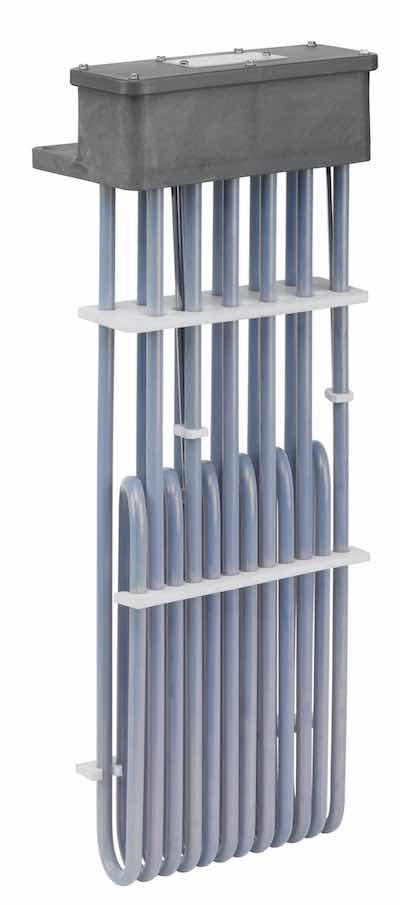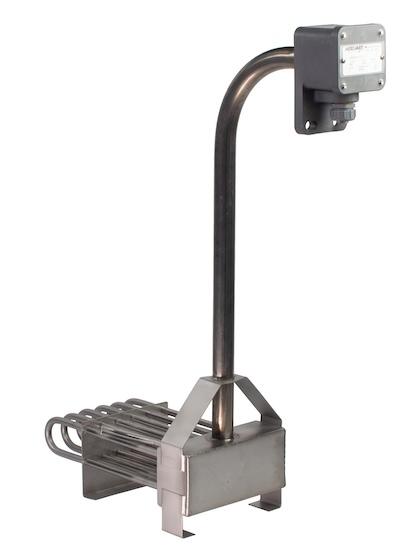Electric immersion heaters are a common sight in plating shops across North America.
 Luke LeonardBut, knowing how to choose and use them well is not necessarily common knowledge. This article will help you pick and use industrial immersion heaters for metal finishing and check if the heater you have now is right for your needs.
Luke LeonardBut, knowing how to choose and use them well is not necessarily common knowledge. This article will help you pick and use industrial immersion heaters for metal finishing and check if the heater you have now is right for your needs.
Many prefer electric immersion heaters because they heat directly, making them energy-efficient and faster heat-up times. In metal finishing, direct heating means placing an "over-the-side" heater mounted on the tank's top edge with the elements submerged in the tank solution below.
Being in direct contact with the solution and this means you must pick the right design to make sure the heater has a long lifespan and does not fail prematurely.
Alloy Selection
 One of the unique features of a metal finishing environment is its use of corrosive solutions to prepare and plate parts. Corrosive solutions can be heated directly as long as the right heater alloy is used. A simplified guide on which heater alloys are compatible with your chemical solution can be found here: https://heatmaxheaters.com/support/Chemical-Compatibility-Guide/
One of the unique features of a metal finishing environment is its use of corrosive solutions to prepare and plate parts. Corrosive solutions can be heated directly as long as the right heater alloy is used. A simplified guide on which heater alloys are compatible with your chemical solution can be found here: https://heatmaxheaters.com/support/Chemical-Compatibility-Guide/
In general, 304 stainless steel has the least resistance to chemicals. Next is 316 stainless steel, followed by Incoloy 800, Titanium, and finally PTFE coated elements. Each offering more resistance and working with more chemicals, but also costing more. There are exceptions to this rule. For example fluorides can harm Titanium elements but are less harsh on stainless steel.
A good rule of thumb is that the more corrosion resistance offered by an alloy, the more it costs. For stainless steel and Incoloy, this is related to its nickel content. Nickel is a very strong mineral that stands up well to a wide range of chemicals. However, nickel is costly, which raises the material cost of a heater. The key is to choose an alloy that resists rust enough for your needs without spending more than you have to.
PTFE, fluoropolymer-coated heater elements offer the best defense against harsh acids. This is not due to their strength but because they are "slippery." The PTFE coating makes it hard for corrosive chemicals to stick to and react with the heater's surface.
Cold Length and Heater Design
Immersion heaters are designed to heat a water-based solution. The heated section must be in the liquid while running. If run in air, the heated section could overheat, which may shorten the life of the heater or damage the tank. To span the gap between the top of the tank where the heater is mounted and the liquid level, metal plating heaters have a “cold length” and a “liquid level bar.”
The cold length is a section of the element that is not heated but carries power to the heated section. The liquid level bar is a visual guide showing where the lowest liquid level should be. The liquid level should be kept at least 3” above the heated section.
The best way to ensure smooth operation is to tell your heater manufacturer what your tank’s liquid level will be so they can adjust the heater’s cold section length to fit. For tanks with low or variable liquid levels, “L-shaped” or “bottom” heaters are recommended as a way of keeping the heated elements at the bottom of the tank. Bottom heaters come in both horizontally and vertically stacked configurations to leave space in your tank for submerged parts.
Watt Density
 Watt density is a proxy for the surface temperature of the heater element. The higher the watt density, the more energy it puts out in a small area, making the element hotter.
Watt density is a proxy for the surface temperature of the heater element. The higher the watt density, the more energy it puts out in a small area, making the element hotter.
A “standard” watt density is 35 to 40 watts per square inch. This is suitable for most water-based solutions. Some chemistries, however, require “derated” elements.
A derated element has a watt density of 18 (or less) watts per square inch. This is usually needed in two cases. (1) A corrosive chemical reaction that is accelerated at higher temperatures, an environment in which a lower watt density element would last longer. (2) some chemicals, like Potassium, are attracted to and build up on a heated surface. Derating heater elements in these circumstances will slow down the rate of build-up.
Please see our chemical compatibility guide to see if a heater should be derated for your application: https://heatmaxheaters.com/support/Chemical-Compatibility-Guide/
Wattage
The wattage of a heater will be listed on its label along with the volts and amperage. e wattage tells you how much heat the heater can generate. If you need a faster heat-up time, or if you are sizing a heater for a new tank, you can use a calculator to find out how much wattage is needed to reach your target temperature within your target time frame: https://heatmaxheaters.com/support/heatmax-calculator/
Luke Leonard is the President of Heatmax Heaters. Visit https://heatmaxheaters.com































